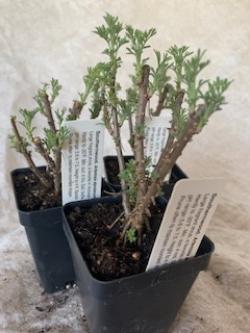Your search for Plants begining with the letter S returned 136 items.
A | B | C | D | E | F | G | H | I | J | K | L | M | N | O | P | Q | R | S | T | U | V | W | X | Y | Z
Displaying items 76 thru 90
Sorrel, French.
Rumex acetosa. Described by gourmets as having a "refreshing acidity", this pot herb enhances a variety of meat, fish, poultry, egg, and vegetable dishes. Very large green leaves are produced by the plant and harvested to be eaten fresh or cooked. Sorrel is best known for its use in a creamy French soup that is pleasingly habit forming. Its long, broad arrow-shaped leaves are also tasty chopped and mixed with salad greens. It is often the first perennial herb to break the spring soil, as early as mid-February. As summer approaches flower stalks emerge and foliage production declines. By removing the flower stems, and with ample water and fertilizer, plants will produce leaves until late fall. Sorrel does not spread but it clumps and may be divided every three or four years to renew the bed. Site a sorrel bed where plants will receive at least 3 hours of full sun with a pH around 6.0; moderately fertile, well-drained soil is essential. Plants in their vegetative stage are about 12 inches tall; flower stems may reach 3 feet. Clumps are usually not more than 10 inches in diameter.Last Seed Source: www.johnnyseeds.com
Sorrel, Red Veined.
Rumex sanguineus ssp sanguineus. Unusual, purple-veined, green leaves make a statement in the border, and it is edible too. Grows up to 3 feet tall in full sun to partial shade. Tender young leaves can be used in salads.Southernwood.
Artemisia abrotanum. With a history of medicinal and other uses, this aromatic, ornamental Artemisia has feathery foliage and a lemony aroma. It was one of the colonial "strewing" herbs that scented rustic cabins and courtrooms when walked upon. It was also a favorite in Victorian gardens. Today southernwood is a substantial ornamental, widely adapted to making wreaths and dried arrangements. Hardy to -20°F. Plants may reach 3 to 4 feet and are about 3 feet in diameter.Spinach.
Spinacia oleracea 'Tyee'. Description not available at this timeLast Seed Source: www.johnnyseeds.com
Squash, Zucchini.
'Black Beauty'. 55 days. Dwarf, bushy vines produce cylindrical, long, smooth, dark-green fruit with greenish white flesh. Space plants 3 to 4 feet apart. Feed/fertilize regularly. Water regularly once flowers appear until fruits ripen.Last Seed Source: www.seedsavers.org
Squash, Zucchini.
'Cocozelle'. 42-56 days. Bush type. Long, cylindrical fruit is dark green with light green stripes. Plant 3 to 4 feet apart. Fertilize/feed regularly throughout the season. Water regularly once flowers appear until fruits ripen. Do not disturb roots when transplanting.Last Seed Source: www.germaniaseed.com
Squash, Zucchini.
'Costata Romanesco'. 52 days to harvest. A traditional Italian heirloom. This distinctive zucchini is medium gray-green, with pale green flecks and prominent ribs. Big, large-leafed, trailing vines produce only half the yield of hybrids, but much have a flavor, nutty, and delicious, raw or cooked. Also a good producer of heavy male blossom buds for cooking.Last Seed Source: www.johnnyseeds.com
Squash, Summer.
Cucurbita pepo 'Prolific Straightneck'. 50 days. 1938 AAS Winner. Uniform lemon-yellow, club-shaped fruit. Firm flesh is of excellent quality. Harvest when 3 to 7 inches long. Plants are vigorous, hardy, and productive. Space 2 to 3 feet apart. Do not disturb roots when transplanting.Last Seed Source: www.germaniaseed.com
Squash, Yellow Patty Pan.
Cucurbita pepo 'Sunburst F1'. 52 days. 1985 All-America Selections winner. Prolific producer of tender, rounded squash with a scalloped profile. Vigorous plant. Plant 2 to 3 feet apart. Do not disturb roots when transplantingLast Seed Source: www.johnnyseeds.com
Stachys officinalis
'Pink Cotton Candy'.Stevia.
Stevia rebaudiana. Tender perennial. Slender upright plant with sweet leaves, hundreds of times sweeter than sugar, with no calories. It can be used as an alternative sweetener for diabetics. Making a sugar substitute from the plant is beyond the capability of most gardeners. Use of the plant as a sweetener is limited to tea or other beverages.Strawberry, Alpine.
. These small, conical, deep red berries have delicate, soft flesh that is perfume-sweet when fully ripe. It is no wonder that Charles V of France was captivated by them in 1360 and brought them from the woods to his garden. These modern offspring of his fraises des bois bear the royal breeding of the originals; they are refined, well-mannered, everbearing plants that are compact and runnerless. Commercial growers gave up the cultivation of these strawberries decades ago, an event attributed to the need for large, eye-popping berries that traveled well, no matter their taste. Space plants 12 inches apart in full sun or part shade. Soil should be rich in humus, deeply dug, and drain well. Keep plants watered well during dry, hot summer months. Alpine strawberries are produced from June until frost. They are best enjoyed right off the vine, since they do not store well. Crowns may be divided every three years to produce additional plants. When transplanting, be sure the crown of the plant is above soil level.Last Seed Source: www.johnnyseeds.com

